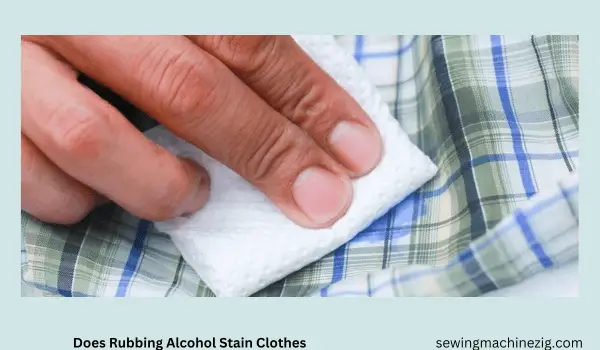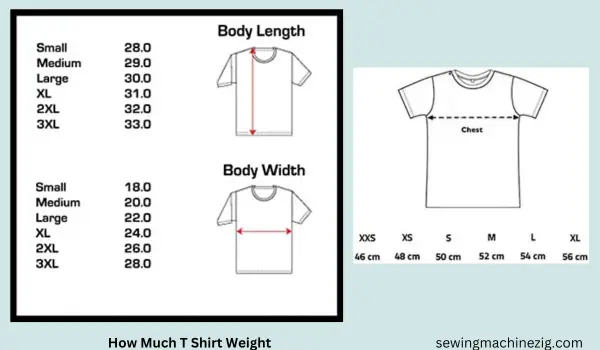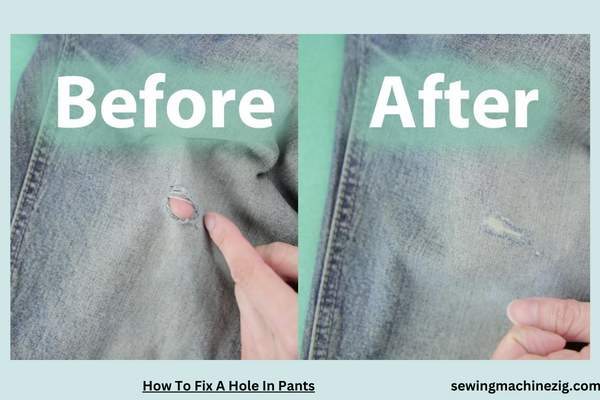
When your favorite pair of pants develops an unexpected hole, there’s no need to bid them farewell just yet. Wondering how to fix a hole in pants without expert sewing skills or visible patches? This article unveils clever and accessible solutions to mend those wardrobe mishaps seamlessly.
From simple hand-sewing techniques to fabric-friendly adhesives, we’ll guide you through the process, ensuring your pants are back in action with a discreet repair. Say goodbye to the frustration of unwanted holes and hello to a revived wardrobe staple with these practical and resourceful fixes. “how to fix a hole in pants“
How To Fix A Hole In Pants Detailed Answer
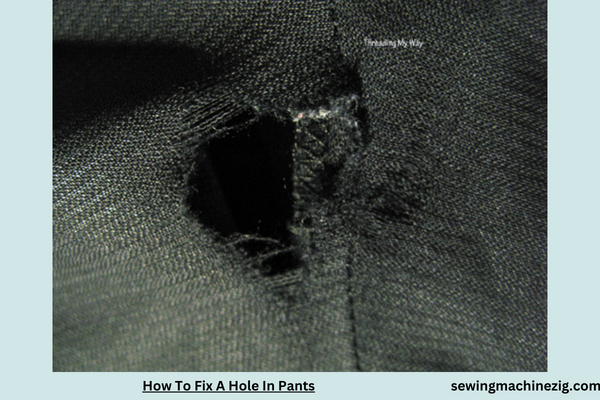
Embarking on a mission to fix a hole in your pants is a journey of both necessity and creativity. Whether your favorite pair has succumbed to the wear and tear of everyday life or you’ve snagged a stylish new pair that needs a quick rescue, fear not – we’re here to guide you through the process with a touch of ingenuity and a dash of DIY magic.
In this comprehensive guide, how to fix a hole in pants, We’ll explore various methods for fixing a hole in your pants, ranging from quick and simple stitches to creative and stylish patching techniques.
Understanding the Hole Dilemma: A Prelude to Fashion Resuscitation
Before we dive into the hands-on process of fixing a hole in your pants, let’s take a moment to appreciate the relationship we have with our favorite garments. Pants, whether they’re a trusty pair of jeans or a stylish addition to your wardrobe, often bear the marks of our adventures and everyday experiences. From accidental snags to wear-induced holes, these imperfections tell a story – and sometimes, that story needs a little creative intervention.
Gathering Your Repair Arsenal: Tools of the Trade
- Needle and Thread:
- A classic and essential tool for any sewing endeavor.
- Choose a thread color that matches your pants for a seamless repair.
- Fabric Scissors:
- Sharp scissors specifically designed for cutting fabric will make the process smoother.
- Ensure they’re clean and free from any residual materials.
- Fabric Patch or Scrap:
- A piece of fabric that matches the color and weight of your pants.
- This can be a pre-made fabric patch or a scrap from an old pair of pants or fabric stash.
- Iron-On Patch:
- An adhesive patch that can be applied with heat for a quick and easy fix.
- Choose a patch that complements the style of your pants.
- Fabric Glue:
- A versatile adhesive that can be used for both small and large repairs.
- Ensure the fabric glue is suitable for clothing repairs.
- Sewing Machine (Optional):
- If you prefer a quicker and more uniform repair, a sewing machine can be a valuable asset.
- Ensure the machine is threaded and in good working condition.
- Embellishments (Optional):
- Buttons, sequins, or fabric embellishments can add a stylish touch to your repair.
- Consider these elements for both functional and aesthetic purposes.
Step-by-Step Guide to Fixing a Hole in Pants: A Fashion Odyssey
- Assess the Hole:
- Examine the hole in your pants to determine its size, location, and the overall condition of the fabric.
- If there are loose threads, trim them carefully to create a clean edge.
- Choose Your Repair Method:
- Depending on the size and type of hole, select the most suitable repair method from your arsenal.
- For smaller holes, consider traditional hand stitching. For larger holes, you may opt for a fabric patch or iron-on patch.
- Prepare the Pants:
- Ensure the area around the hole is clean and free of any dirt or debris.
- If the pants are wrinkled, use an iron to create a smooth surface for the repair.
- Traditional Hand Stitching:
- Thread your needle with a length of thread, doubling it for added strength. Tie a knot at the end.
- Starting from the inside of the pants, insert the needle through the fabric and pull it through.
- Use a basic running stitch, whipstitch, or backstitch to close the hole. Repeat until the hole is securely stitched.
- Using a Sewing Machine (Optional):
- If you’re comfortable using a sewing machine, set it up with the appropriate thread color.
- Position the pants under the machine, aligning the hole with the needle.
- Use a straight stitch or a zigzag stitch, depending on the type of repair needed.
- Applying a Fabric Patch:
- If you have a fabric patch or scrap, cut it to a size slightly larger than the hole.
- Position the patch on the inside of the pants, aligning it with the hole.
- Hand stitch or use a sewing machine to secure the patch, ensuring it covers the hole completely.
- Using an Iron-On Patch:
- Select an iron-on patch that matches your pants or adds a stylish contrast.
- Position the patch over the hole on the outside of the pants.
- Place a cloth over the patch to protect it, then iron according to the instructions provided with the patch.
- Applying Fabric Glue:
- For a quick and easy fix, apply fabric glue to the edges of the hole.
- Press the edges together to create a seamless bond. Hold in place until the glue sets.
- For added strength, place a heavy object or clamp over the glued area.
- Enhancing with Embellishments (Optional):
- Elevate your repair by adding decorative elements like buttons or sequins.
- Use fabric glue to secure these elements, turning a functional repair into a stylish statement.
- Allow for Drying Time:
- Regardless of the method you choose, allow the adhesive or stitching to dry or set completely before wearing the pants.
- Follow the drying time specified on the product or consider leaving the pants overnight.
Tips for a Successful Fashion Rescue: A Stitch in Time
- Choose the Right Thread:
- Opt for a strong and durable thread, especially if the repair is in a high-stress area like the knees.
- Match the thread color to your pants for a seamless finish.
- Secure Loose Threads:
- Before stitching, make sure there are no loose threads around the damaged area. Trim any stray threads to create a clean canvas for your repair.
- Test on a Small Area:
- If you’re using a new fabric patch, glue, or embellishments, consider testing them on a small, inconspicuous area first.
- This ensures compatibility with your fabric and allows you to gauge the effectiveness of the method.
- Blend with the Design:
- Embrace the repair as part of the design by choosing elements that blend seamlessly with the overall aesthetic of your pants.
- Consider the repair an opportunity to add a touch of uniqueness to your wardrobe.
- Reinforce High-Stress Areas:
- If the hole is in a high-stress area, such as the knees, consider reinforcing the repair with additional stitching, fabric, or patches.
- This prevents the repair from coming undone with regular movement.
- Wash with Care:
- When washing pants with a repair, follow the care instructions provided for the specific repair method used.
- Turn the pants inside out to protect the repaired area.
In Summary: A Rescued Wardrobe Staple
Fixing a hole in your pants is not just a practical task; it’s an opportunity to showcase your creativity and resourcefulness. Armed with a needle, thread, fabric patches, and a touch of flair, you can turn a potential fashion crisis into a personalized masterpiece.
So, the next time you find yourself facing a hole in your favorite pair of pants, seize the opportunity to embark on a fashion rescue
How To Fix Ripped Jeans
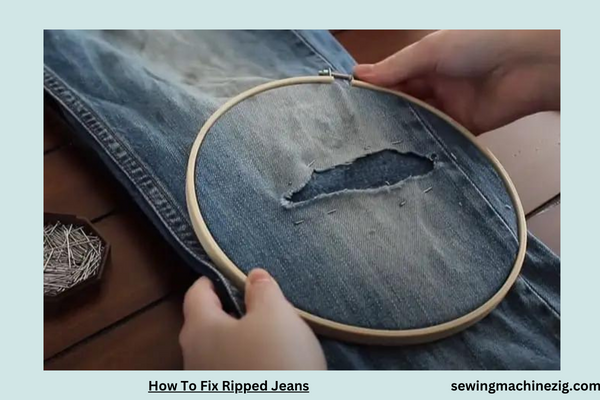
Embarking on the journey to fix ripped jeans is not just a practical endeavor but an opportunity to transform a wardrobe staple into a fashion statement. Whether your beloved denim has fallen victim to the wear and tear of time or you’ve intentionally embraced the distressed look.
This comprehensive guide will walk you through creative and effective methods to mend and enhance your ripped jeans. Get ready to embark on a denim rescue mission that combines functionality with a touch of unique style.
Understanding the Ripped Jeans Phenomenon: A Prelude to Denim Revival
Before we delve into the hands-on process of fixing ripped jeans, let’s take a moment to appreciate the charm of distressed denim. Ripped jeans have evolved from a symbol of rebellion to a fashion statement embraced by style icons worldwide. The intentional tears and frays tell a story of adventure, and when it comes to fixing them, it’s about preserving that narrative while adding your own creative touch.
Gathering Your Denim Rescue Arsenal: Tools of the Trade
- Needle and Thread:
- A classic and essential tool for any denim repair project.
- Choose a heavy-duty thread in a color that complements your jeans.
- Fabric Patch or Scrap:
- A piece of fabric that matches the color and weight of your jeans.
- This can be a pre-made fabric patch or a scrap from an old pair of jeans.
- Iron-On Patch:
- An adhesive patch that can be applied with heat for a quick and easy fix.
- Choose a patch that matches the style of your jeans or contrasts for a bold statement.
- Fabric Glue:
- A versatile adhesive that can be used for both small and large repairs.
- Ensure the fabric glue is suitable for denim repairs.
- Sewing Machine (Optional):
- If you prefer a quicker and more uniform repair, a sewing machine can be a valuable asset.
- Ensure the machine is threaded and in good working condition.
- Embellishments (Optional):
- Buttons, studs, or fabric embellishments can add a stylish and personalized touch to your repaired jeans.
- Consider these elements for both functional and aesthetic purposes.
Step-by-Step Guide to Fixing Ripped Jeans: A Denim Revival Odyssey
- Assess the Ripped Area:
- Examine the ripped area in your jeans to understand the extent of the damage and the overall condition of the denim.
- Note any loose threads and trim them carefully to create a clean canvas for repair.
- Choose Your Repair Method:
- Depending on the size and type of rip, select the most suitable repair method from your denim rescue arsenal.
- For smaller tears, consider traditional hand stitching or using fabric glue. For larger rips, fabric or iron-on patches may be more effective.
- Prepare the Jeans:
- Ensure the area around the rip is clean and free of any dirt or debris.
- If the jeans are wrinkled, use an iron to create a smooth surface for the repair.
- Traditional Hand Stitching:
- Thread your needle with a length of heavy-duty thread, doubling it for added strength. Tie a knot at the end.
- Starting from the inside of the jeans, insert the needle through the fabric and pull it through.
- Use a basic running stitch, whipstitch, or backstitch to close the rip. Repeat until the rip is securely stitched.
- Using a Sewing Machine (Optional):
- If you’re comfortable using a sewing machine, set it up with the appropriate thread color.
- Position the jeans under the machine, aligning the rip with the needle.
- Use a straight stitch or a zigzag stitch, depending on the type of repair needed.
- Applying a Fabric Patch:
- If you have a fabric patch or scrap, cut it to a size slightly larger than the rip.
- Position the patch on the inside of the jeans, aligning it with the rip.
- Hand stitch or use a sewing machine to secure the patch, ensuring it covers the rip completely.
- Using an Iron-On Patch:
- Select an iron-on patch that matches your jeans or adds a stylish contrast.
- Position the patch over the rip on the outside of the jeans.
- Place a cloth over the patch to protect it, then iron according to the instructions provided with the patch.
- Applying Fabric Glue:
- For a quick and easy fix, apply fabric glue to the edges of the rip.
- Press the edges together to create a seamless bond. Hold in place until the glue sets.
- For added strength, place a heavy object or clamp over the glued area.
- Enhancing with Embellishments (Optional):
- Elevate your repair by adding decorative elements like buttons, studs, or fabric embellishments.
- Use fabric glue to secure these elements, turning a functional repair into a stylish statement.
- Allow for Drying or Setting Time:
- Regardless of the method you choose, allow the adhesive or stitching to dry or set completely before wearing the jeans.
- Follow the drying time specified on the product or consider leaving the jeans overnight.
Tips for a Successful Denim Revival: Crafting a Unique Pair
- Choose the Right Thread:
- Opt for a heavy-duty thread that matches the color of your jeans for a seamless finish.
- Ensure the thread is strong enough to withstand the stresses on the repaired area.
- Secure Loose Threads:
- Before stitching, make sure there are no loose threads around the damaged area. Trim any stray threads to create a clean canvas for your repair.
- Test on a Small Area:
- If you’re using a new fabric patch, glue, or embellishments, consider testing them on a small, inconspicuous area first.
- This ensures compatibility with your denim and allows you to gauge the effectiveness of the method.
- Blend with the Design:
- Embrace the repair as part of the design by choosing elements that blend seamlessly with the overall aesthetic of your jeans.
- Consider the repair an opportunity to add a touch of uniqueness to your denim.
- Reinforce High-Stress Areas:
- If the rip is in a high-stress area, such as the knees, consider reinforcing the repair with additional stitching, fabric, or patches.
- This prevents the repair from coming undone with regular movement.
- Wash with Care:
- When washing jeans with a repair, follow the care instructions provided for the specific repair method used.
- Turn the jeans inside out to protect the repaired area.
In Summary: A Personalized Denim Masterpiece
Fixing ripped jeans is not just about mending; it’s an opportunity to showcase your creativity and transform a wardrobe staple into a personalized masterpiece. Armed with a needle, thread, fabric patches, and a touch of flair, you can turn a distressed pair into a unique fashion statement.
So, the next time you find yourself facing a rip in your favorite pair of jeans, seize the opportunity to embark on a denim revival. With creativity as your guide and denim in hand, you can turn a potential fashion setback into a stylish triumph. Happy crafting, denim artisan!
How To Fix Holes In Jeans Inner Thigh
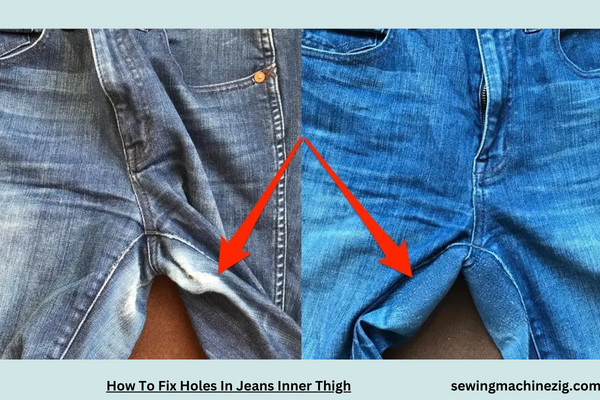
Embarking on the mission to fix holes in the inner thigh of your favorite jeans is not just a practical endeavor; it’s a journey of denim revival and personalized style. Whether your beloved denim has succumbed to the friction of everyday wear or you’re looking to rescue a pair with sentimental value. “how to fix a hole in pants“
This comprehensive guide will walk you through creative and effective methods to mend and enhance your jeans. Get ready to turn a potential fashion setback into a unique statement, blending functionality with a touch of ingenuity.
Understanding the Inner Thigh Dilemma: A Prelude to Denim Resurrection
Before we delve into the hands-on process of fixing holes in the inner thigh of your jeans, let’s take a moment to acknowledge the commonality of this issue. The inner thigh area is prone to wear and tear due to the constant rubbing of fabric against each other. However, instead of seeing this as a mere problem, let’s view it as an opportunity to breathe new life into your jeans and showcase your creativity through the mending process.
Gathering Your Denim Resurrection Arsenal: Tools of the Trade
- Needle and Thread:
- A classic and essential tool for any denim repair project.
- Choose a strong and durable thread that matches the color of your jeans for a seamless finish.
- Fabric Patch or Scrap:
- A piece of denim or fabric that matches the color and weight of your jeans.
- This can be a pre-made fabric patch or a scrap from an old pair of jeans.
- Iron-On Patch:
- An adhesive patch that can be applied with heat for a quick and easy fix.
- Choose a patch that matches the style of your jeans or provides a contrasting and stylish touch.
- Fabric Glue:
- A versatile adhesive that can be used for both small and large repairs.
- Ensure the fabric glue is suitable for denim repairs.
- Sewing Machine (Optional):
- If you prefer a quicker and more uniform repair, a sewing machine can be a valuable asset.
- Ensure the machine is threaded and in good working condition.
- Embellishments (Optional):
- Buttons, studs, or fabric embellishments can add a stylish and personalized touch to your repaired jeans.
- Consider these elements for both functional and aesthetic purposes.
Step-by-Step Guide to Fixing Holes in Jeans Inner Thigh: A Denim Resurrection Odyssey
- Assess the Inner Thigh Area:
- Examine the holes in the inner thigh of your jeans to understand the extent of the damage and the overall condition of the denim.
- Note any loose threads and trim them carefully to create a clean canvas for repair.
- Choose Your Repair Method:
- Depending on the size and type of hole, select the most suitable repair method from your denim resurrection arsenal.
- For smaller holes, consider traditional hand stitching or using fabric glue. For larger holes, fabric or iron-on patches may be more effective.
- Prepare the Jeans:
- Ensure the area around the holes is clean and free of any dirt or debris.
- If the jeans are wrinkled, use an iron to create a smooth surface for the repair.
- Traditional Hand Stitching:
- Thread your needle with a length of strong and durable thread, doubling it for added strength. Tie a knot at the end.
- Starting from the inside of the jeans, insert the needle through the fabric and pull it through.
- Use a basic running stitch, whipstitch, or backstitch to close the holes. Repeat until the holes are securely stitched.
- Using a Sewing Machine (Optional):
- If you’re comfortable using a sewing machine, set it up with the appropriate thread color.
- Position the jeans under the machine, aligning the holes with the needle.
- Use a straight stitch or a zigzag stitch, depending on the type of repair needed.
- Applying a Fabric Patch:
- If you have a fabric patch or scrap, cut it to a size slightly larger than the holes.
- Position the patch on the inside of the jeans, aligning it with the holes.
- Hand stitch or use a sewing machine to secure the patch, ensuring it covers the holes completely.
- Using an Iron-On Patch:
- Select an iron-on patch that matches your jeans or adds a stylish contrast.
- Position the patch over the holes on the outside of the jeans.
- Place a cloth over the patch to protect it, then iron according to the instructions provided with the patch.
- Applying Fabric Glue:
- For a quick and easy fix, apply fabric glue to the edges of the holes.
- Press the edges together to create a seamless bond. Hold in place until the glue sets.
- For added strength, place a heavy object or clamp over the glued area.
- Enhancing with Embellishments (Optional):
- Elevate your repair by adding decorative elements like buttons, studs, or fabric embellishments.
- Use fabric glue to secure these elements, turning a functional repair into a stylish statement.
- Allow for Drying or Setting Time:
- Regardless of the method you choose, allow the adhesive or stitching to dry or set completely before wearing the jeans.
- Follow the drying time specified on the product or consider leaving the jeans overnight.
Tips for a Successful Denim Resurrection: Crafting a Unique Pair
- Choose the Right Thread:
- Opt for a strong and durable thread that matches the color of your jeans for a seamless finish.
- Ensure the thread is robust enough to withstand the stresses on the repaired area.
- Secure Loose Threads:
- Before stitching, make sure there are no loose threads around the damaged area. Trim any stray threads to create a clean canvas for your repair.
- Test on a Small Area:
- If you’re using a new fabric patch, glue, or embellishments, consider testing them on a small, inconspicuous area first.
- This ensures
Conclusion
Embarking on the journey of mending a hole in pants transforms the ordinary into a bespoke tapestry of repair. With needle and thread as the artisan’s tools, each stitch becomes a testament to resilience and resourcefulness.
The guide, a tailor’s whispered secret, guides the hands through the intricate ballet of fabric restoration. So, in the quiet theatre of garment revival, the how-to guide on fixing a hole in pants stages a unique performance, where threads weave a story of resilience and fashion reincarnation.
FAQs: How To Fix A Hole In Pants?
Q1: Can you repair a hole in pants at home, and what tools are important for the fix?
A1: Yes, you can fix a hole in pants at home. How to fix a hole in pants effectively? Important tools include a needle, thread, fabric scissors, and a fabric patch or matching fabric. These tools are important for various repair techniques, ensuring a successful and durable mend.how to fix a hole in pants
Q2: What sewing techniques are important when fixing a hole in pants, and can beginners handle the repair process?
A2: Basic sewing techniques are important when fixing a hole in pants. How to fix a hole in pants for beginners? It’s crucial to start with simple stitches like the running stitch or whipstitch. Online tutorials can provide step-by-step guidance, making the repair process accessible for beginners. “how to fix a hole in pants“
Q3: Is it possible to fix a hole in pants without using a sewing machine, and what alternatives are recommended?
A3: Yes, you can fix a hole in pants without a sewing machine. How to fix a hole in pants without a sewing machine? It’s possible by using hand-sewing techniques, such as the backstitch or blanket stitch. Additionally, fabric glue or iron-on fabric repair tape are important alternatives for a no-sew option. “how to fix a hole in pants“
Q4: Are there specific considerations when fixing a hole in pants made of different fabrics?
A4: Yes, fabric considerations are important when fixing a hole in pants. How to fix a hole in pants made of denim or cotton? It’s important to match the repair method to the fabric type. For denim, consider a patch or visible stitching. For delicate fabrics, a more discreet approach using invisible mending techniques is important for maintaining the garment’s original look. “how to fix a hole in pants“
Q5: Can you wash pants normally after fixing a hole, and what care is important for the repaired area?
A5: Yes, you can wash pants normally after fixing a hole. How to fix a hole in pants that withstands washing? It’s crucial to follow any care instructions associated with the chosen repair method. Allowing sufficient drying time after the fix is important to ensure the repair is secure and maintains its integrity through regular laundering. “how to fix a hole in pants“
Q6: How does fixing a hole in pants contribute to sustainable fashion practices, and why is this an important consideration?
A6: Fixing a hole in pants aligns with sustainable fashion practices. How to fix a hole in pants sustainably? Repairing clothing promotes longevity, reducing the need for frequent replacements and minimizing textile waste. It’s important to embrace repair as a conscious choice, contributing to a more sustainable and eco-friendly approach to fashion. “how to fix a hole in pants“


